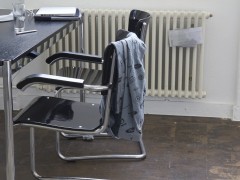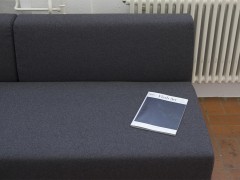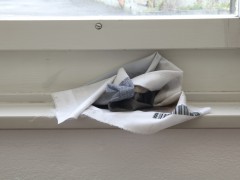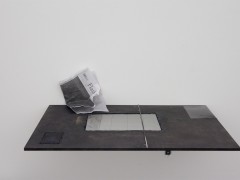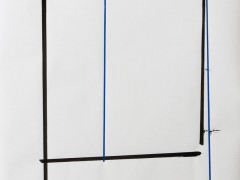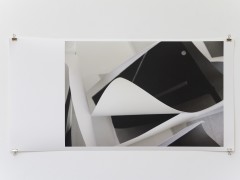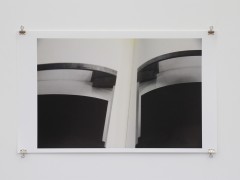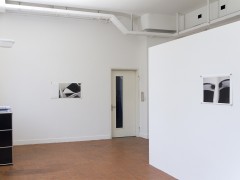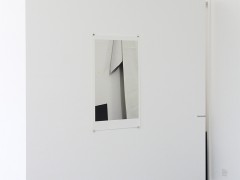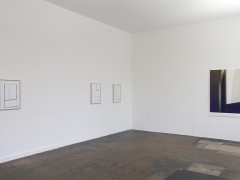Eva Barto y Jesús Alberto Benitez
6.12/2014 – 24.1/2015
annex14, Zürich
annex14 is delighted to present a double exhibition of works by Eva Barto (*1987, FR) and Jesús Alberto Benitez (*1978, VE), two young artists who live in France and are exhibiting in Switzerland for the first time. Eva Barto’s installative interplay between context and work creates ambiguous situations that confuse our ideas of art and reality, fiction and the everyday. By contrast, Jesus Alberto Benitez’ reduced works, hisphotographs and drawings, resemble a poetic exploration of space, time, material, chance and pictorial reality.
In his book La poétique de l’espace, published in 1957, Gaston Bachelard deals with the poetic force of the imagination, whose images he did not regard an echoe from the past. It was instead the appearance of an artwork that awakened in our consciousness echoes of the distant past. Gaston’s advocacy of the moment of the image’s genesis, which grants it autonomy and an unsettling depth and worldliness, takes on a new topicality in the work of Jesús Alberto Benitez. His way of thinking and of working are guided by conceptual considerations which remain open to the unexpected, the moment. His 2014 drawings in particular, as a kind of response to his earlier paintings which were dominated by the importance of process and chance for their genesis, captivate us through their balance between precision, minimalism and gestural assurance. The few, mostly straight, lines, which cut at different points, are kept hovering and their openness enables them to be themselves, yet also makes them amenable to different associations. Drawings like these go deep, are self-reflective regarding the medium and mirror the creative process. Their oscillation between the two- and the three-dimensional prompts general experiences of proximity and distance, space, time, line and plane, while their formal aesthetic features provide us with echoes from the past that give time and space a specific nuance or meaning.
The compositional organisation of the new photographs by Jesús Alberto Benitez is also quite independent. As depictions, they simultaneously refer to something that is already there, to studio situations, for example, or to excerpts from other depictions, as in Derivée (2013). Here they are drawings by Richard Serra, which in themselves already stretch the limits of the two-dimensional medium. What clearly emerges is the spatial-plastic interplay of different realities in real space, for example, as a result of careful hanging. The artist’s interest in the transitory, in how things, materials and levels of meaning become superimposed or shifted, reverberates here.
As in the case of Jesús Alberto Benitez, in Eva Barto’s work we also see how borders are transformed, how intermediary spaces shift into focus and how the ephemeral challenges perception. While in Benitez the intensity is in the visual, the pictorial, which at first sight eschews language, Barto’s spatial settings initially exhibit a playful narrative level to the extent that one can distinguish the art. This is where the artist’s particular approach comes into play. Eva Barto regards art spaces, i.e., also the gallery, as territories where everything is up for negotiation, where ideas about art and non-art are questioned in various ways. In this exhibition the first irritations arise because changes of a more covert nature have been made to the space itself. Works like Ownership in crisis (2013) or II IIII (2013), moreover, lie or hang here like forgotten remnants of past events. Other works make it difficult to distinguish between purely functional furnishings and art object. The relations between artwork, audience and gallery are not fixed, they are being constantly renegotiated and therefore, in Eva Barto’s, view an important component of the work itself. Her praxis is not purely sculptural or installative in the traditional sense. Eva Barto plays with the reality of the work and the space, juggles constantly with construction and deconstruction, and so prevents their status from ever being fixed, sometimes enigmatically, sometimes with a wink to the viewer. To this extent, she is also concerned with very fundamental issues, like the significance and impact of drawing boundaries, power and status, and the social role of art.
Elisabeth Gerber
This post is also available in: Spanish

 Home
Home
